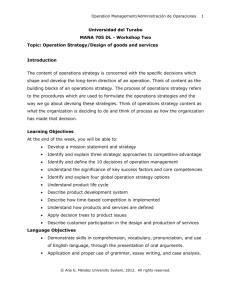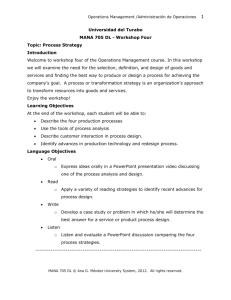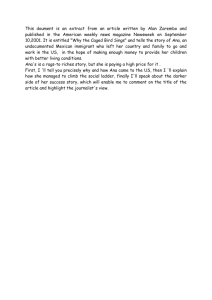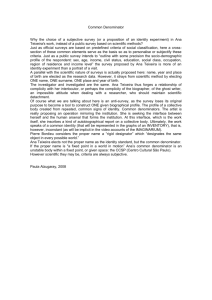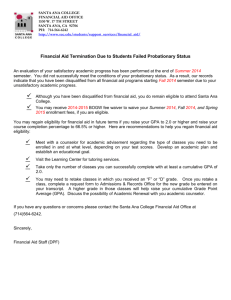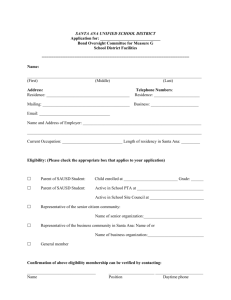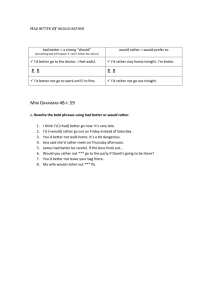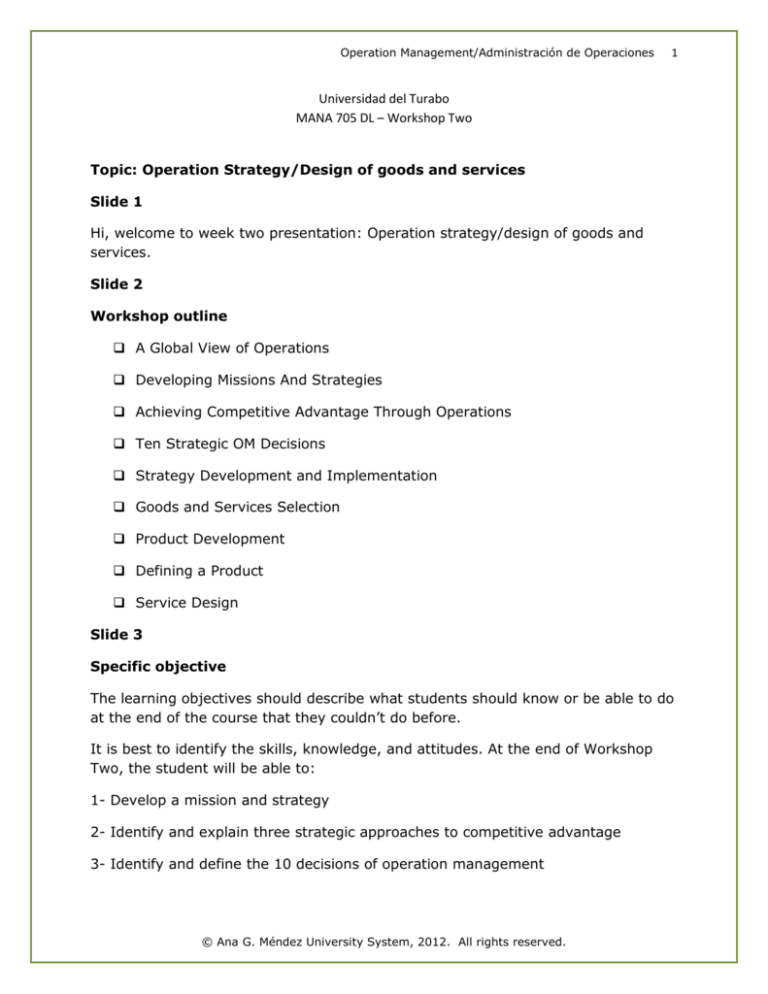
Operation Management/Administración de Operaciones
1
Universidad del Turabo
MANA 705 DL – Workshop Two
Topic: Operation Strategy/Design of goods and services
Slide 1
Hi, welcome to week two presentation: Operation strategy/design of goods and
services.
Slide 2
Workshop outline
A Global View of Operations
Developing Missions And Strategies
Achieving Competitive Advantage Through Operations
Ten Strategic OM Decisions
Strategy Development and Implementation
Goods and Services Selection
Product Development
Defining a Product
Service Design
Slide 3
Specific objective
The learning objectives should describe what students should know or be able to do
at the end of the course that they couldn’t do before.
It is best to identify the skills, knowledge, and attitudes. At the end of Workshop
Two, the student will be able to:
1- Develop a mission and strategy
2- Identify and explain three strategic approaches to competitive advantage
3- Identify and define the 10 decisions of operation management
© Ana G. Méndez University System, 2012. All rights reserved.
Operation Management/Administración de Operaciones
4- Understand the significance of key success factors and core competencies
5- Identify and explain four global operation strategy options.
Slide 4
6. Describe product development system
7. Describe how time-base competition is implemented
8. Understand how products and services are define
9. Apply decision trees to product issues
10. Describe customer participation in the design and production of services
Slide 5
Globalization definition
“Processes by which goods, services, capital, people, information, and ideas flow
across national borders.” (Grewal/Levy)
“Trend toward greater economic, cultural, political, and technological
interdependence among national institutions and economies.” (Wild/Wild/Han)
Nearly 23 trillion dollars accounts for the total value of imports/exports that cross
national borders each year.
Your Everyday Life:
Wake up to a GE alarm clock made in China
Slip on Adidas sandals made in Indonesia
Put your American Eagle clothes on from Mexico
Unplug your Nokia phone made in the U.S. and Taiwan
Hop into your Toyota made in Kentucky
Listen to Coldplay from England
Grap a Starbuck’s coffee with beans harvested in Columbia
Slide 6
The graphic shows the Top ten Globalized Countries
© Ana G. Méndez University System, 2012. All rights reserved.
2
Operation Management/Administración de Operaciones
3
Slide 7
Reasons to globalize:
Many international operations seek to take advantage of the tangible opportunities
to reduce their cost.
The supply chain can often be improved by locating facilities in countries where
unique resources are available.
Although the characteristics of goods and services can be objective and
measurable, they can also be subjective and less measurable. Another reason for
international operation is to reduce time to meet customer changing products and
service requirements.
Because international operations require interaction with foreign customers,
suppliers, and other competitive business, international firms inevitably learn about
opportunities for new product and services.
Firm serve themselves and their customers well when they remain open to the free
flow of ideas.
Global organization can attract and retain better employees by offering more
employment opportunities.
In other words, the reasons to globalize:
1. Reduce costs (labor, taxes, tariffs, etc)
2. Improve supply chain
3. Provide better goods and services
4. Understand markets
5. Learn to improve operations
6. Attract and retain global talent
Slide 8
Competitive advantage
Michael Porter suggested four "generic" business strategies that could be adopted in
order to gain competitive advantage. The four strategies relate to the extent to
© Ana G. Méndez University System, 2012. All rights reserved.
Operation Management/Administración de Operaciones
4
which the scope of businesses' activities are narrow versus broad and the extent to
which a business seeks to differentiate its products.
The four strategies are summarized in the figure:
- The differentiation and cost leadership strategies seek competitive advantage in a
broad range of market or industry segments. By contrast, the differentiation focus
and cost focus strategies are adopted in a narrow market or industry.
- Differentiation is about charging a premium price that more than covers the
additional production costs, and about giving customers clear reasons to prefer the
product over other, less differentiated products.
- The Cost leadership strategy is usually associated with large-scale businesses
offering "standard" products with relatively little differentiation that are perfectly
acceptable to the majority of customers. Occasionally, a low-cost leader will also
discount its product to maximize sales, particularly if it has a significant cost
advantage over the competition and, in doing so, it can further increase its market
share.
- In the differentiation focus strategy, a business aims to differentiate within just
one or a small number of target market segments.
Cost focus business seeks a lower-cost advantage in just one or a small number of
market segments.
Slide 9
Business definition
Business is an activity undertaken for the purpose of making profit or adding wealth
to a person or entity by resorting to financial transaction in order to get a margin of
profit on such transactions.
Slide 10
Developing mission and strategy
An effective operation management effort must have a mission so it knows
where it is going and a strategy so it knows how to get here. This is the case for
small or domestic organization, as well as a large international organization.
Normally, the Mission has three components:
verb
Someone who receives the action of the verb
One result of this action
© Ana G. Méndez University System, 2012. All rights reserved.
Operation Management/Administración de Operaciones
Strategy is the organization’s action plan to achieve the mission. It tells the
organization how to get there.
Slide 11
Hard Rock Café Mission statement example.
Our Mission: To spread the spirit of Rock ‘n’ Roll by delivering an exceptional
entertainment and dining experience. We are committed to being an important,
contributing member of our community and offering the Hard Rock family a fun,
healthy, and nurturing work environment while ensuring our long-term success.
Slide 12
FACTORS AFFECTING MISSION
Mission Statements describe the question: where are you going? Once a company
determines its vision, the next thing to do is to determine its mission. Then, what
factors will affect a company in defining its mission? The graphic illustrates the
factors affecting a mission statement.
Slide 13
Strategy
Each functional area has a strategy for achieving its mission and for helping the
organization reach the overall mission. These strategies exploit opportunities and
strengths, neutralize threats, and avoid weaknesses.
Slide 14
Strategies for competitive advantage
Each of the three strategies provides an opportunity for operation managers to
achieve competitive advantage.
Competitive advantage implies the creation of a system that has a unique
advantage over competitors.
Managers achieve competitive advantage via differentiation, low cost, and
response.
Slide 15
In practice, these three concepts, differentiation, low cost and response are often
implemented via the six specific strategies, flexibility in design and volume, low
cost, delivery, quality, after sale services and broad product line. Operation
© Ana G. Méndez University System, 2012. All rights reserved.
5
Operation Management/Administración de Operaciones
management can increase productivity and generate a sustainable competitive
advantage. Observe the image shown.
Slide 16
10 strategic OM decision
Differentiation, low cost and response can be achieved when managers make
effective decisions in 10 areas of Operation Management. These are collectively
known as operation decisions. The slide shows the 10 decisions of OM that support
mission and implement strategies.
1. Goods and service design
2. Quality
3. Process and capacity design
4. Location selection
5. Layout design
6. Human resources and job design
7. Supply chain management
8. Inventory
9. Scheduling
10.Maintenance
© Ana G. Méndez University System, 2012. All rights reserved.
6
Operation Management/Administración de Operaciones
7
Slide 17
Four international operation strategies
An international business is any firm that engages in international trade or
investment.
Operations managers of international and multinational firms approach global
opportunities with one of four operations strategies: international, multidomestic,
global and transnational. Please evaluate the image.
Slide 18
Goods and Services selection
A service is any primary or supplemental activity that does not produce a physical
item directly.
Currently, the service is defined as the production of intangibles, though they are,
what you can note is that the service is a whole system of activities that have a
business, seeking with them meet customer needs and the maximum satisfaction of
the same .
The elements that come into play in providing a service can be classified as:
the materials that accompany the service, methods and procedures used in
providing the service, those involved in service delivery, equipment and facilities
used during the service delivery process, control measures
Other features of the services are:
reliability, responsiveness, tangible, professionalism, courtesy, credibility, security,
communication, accessibility, Understanding the customer.
Slide 19
Product decision
A world of option exists in the selection, definition and design of product. Product
selection is choosing the good or service to provide customer or clients. Product
decisions are fundamental to an organization’s strategy and have major
implications throughout the operations function.
© Ana G. Méndez University System, 2012. All rights reserved.
Operation Management/Administración de Operaciones
8
Slide 20
Product strategy options
Services organizations like Shouldice Hospital differentiate themselves through their
product. Shouldice differentiates itself by offering a distinctly unique and high
quality product.
Taco Bell has developed and executed a low cost strategy through product design.
Toyota’s strategy is rapid response to changing consumer demand, by executing
the fastest automobile design in an industry. Toyota has driven the speed of
product development down to well under 2 years in an industry whose standard is
still over 2 years.
Slide 21
Product life cycles
Products are born. They live and they die. They are cast aside by changing society.
It may be helpful to think of a product’s life as divided into four phases,
introduction, growth, maturity and decline. This figure shows the four life cycle
stages and the relationship of product sales, cash flow and profit over the life cycle
of a product.
Slide 22
Just as operation managers must be prepared to develop new products, they must
also be prepared to develop strategies for new and existing products. Periodic
examination of products is appropriate because strategies change as products move
through their life cycle. Please observe the table.
Slide 23
Product life cycle
In the introductory phase products are still being “fine- tuned” for the market.
Fine tuning may warrant unusual expenses for: research, product development,
process modification and enhancement, supplier development.
In the growth phase, product design has begun to stabilize, and effective
forecasting of capacity requirements is necessary. Adding or enhancing capacity
may be necessary.
© Ana G. Méndez University System, 2012. All rights reserved.
Operation Management/Administración de Operaciones
9
Slide 24
Product life cycle
Maturity phase- By the time a product is mature, competitors are established.
Decline phase- Management may need to be ruthless with those products whose
life cycle is at an end.
Slide 25
New product opportunity
Aggressive new product development requires that organizations build structures
internally that have open communication with customers, innovative organizational
cultures, aggressive R&D, strong leadership, formal incentives, and training. Only
then can a firm profitably and energetically focus on specific opportunities as the
following:
1- Understanding the customer is the premier issue in new product development.
2- Economic change brings increasing levels of affluence in the long run but
economic cycles and price change in the short run.
3- Sociological and demographic change may appear as decreasing family size.
4- Technological change makes possible everything.
5- Political/legal change brings about new trade agreements.
6- Other changes may be brought.
Slide 26
Product Development System
The product development system may well determine not only product success but
also the firm’s future. In this system, product options go through a series of steps,
each having its own screening and evaluation criteria and providing feedback to
prior steps.
Slide 27
Issues for product development
In addition to developing an effective system and organization structure for product
development, several techniques are important to the design of a product.
© Ana G. Méndez University System, 2012. All rights reserved.
Operation Management/Administración de Operaciones
10
Robust design means that the product is designed so that small variation in
production or assembly do not adversely affect the product.
Modular design offer flexibility to both production and marketing.
CAD is the use of computers to interactively design products and prepare
engineering documentation.
CAM refers to the use of specialized computer programs to direct and control
manufacturing equipment.
Virtual reality is a visual form of communication in which images substitute for the
real thing but still allow the user to respond interactively.
An operations manager’s most ethical, and an environmentally sound, activity is to
enhance productivity while delivering desired goods and services.
Slide 28
Defining the product
Once new goods or services are selected for introduction, they must be defined. A
good or service is defined in terms of its functions that is, what it is to do. The
product is then designed, and the firm determines how the functions are to be
achieved.
Slide 29
Designing services is challenging because they often have unique characteristics.
Service typically includes direct interaction with the customer
Increased opportunity for customization
Reduced productivity
Cost and quality are still determined at the design stage
Delay customization
Modularization
Reduce customer interaction, often through automation
Slide 30
Services design
© Ana G. Méndez University System, 2012. All rights reserved.
Operation Management/Administración de Operaciones
11
When the customer participates in the design process, the service supplier may
have a menu of services from which the customer selects options. At this point the
customer may even participate in the design process. Similarly, the customer may
be involved in the delivery of a service or in both design and delivery.
© Ana G. Méndez University System, 2012. All rights reserved.
Operation Management/Administración de Operaciones
Slide 31
Activities
After completing this presentation, please go to the Tasks to complete the
Workshop activities.
© Ana G. Méndez University System, 2012. All rights reserved.
12

